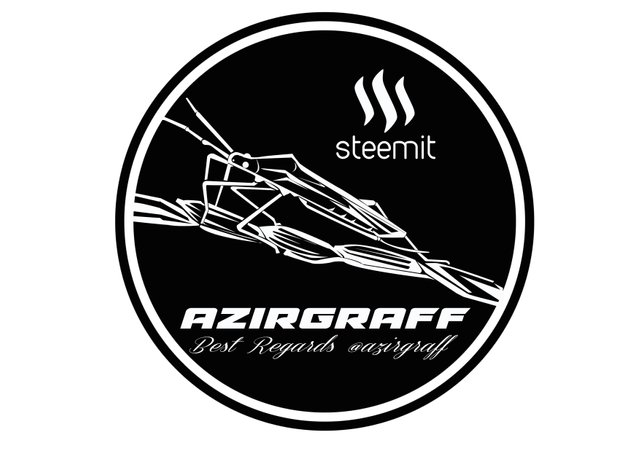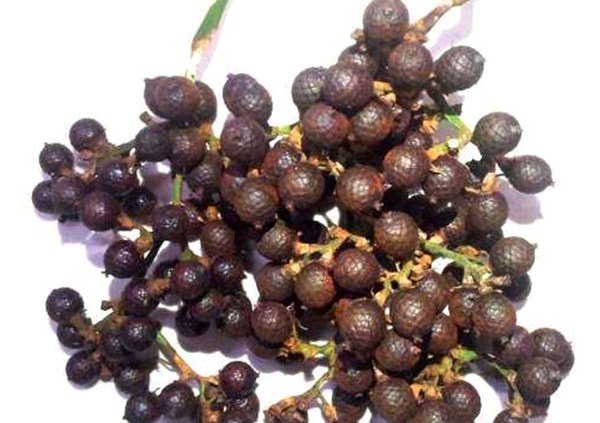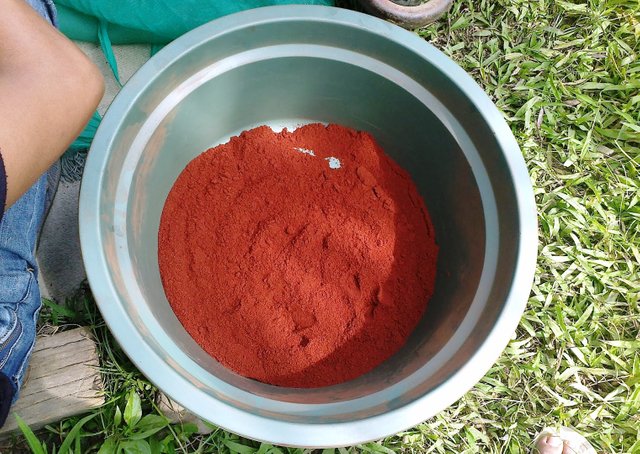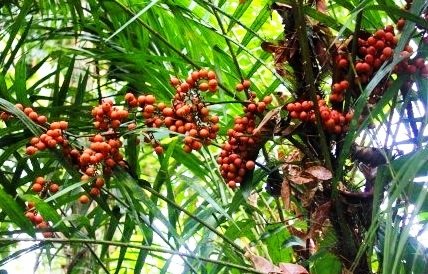Farmers Can Be Rich By Planting This Plant
Hi all my best friend .... How are you all in Steemit? I wish all of you on good health and keep enjoy. In this post I will introduce plants rattan fruit (Jernang). hopefully useful for me and for of you all in Steemit.
During this time probably a lot more people know rubber sap and oil palm as plants that have high economic value. This is reasonable because rubber trees are more popular and many are cultivation in Indonesia, especially in some provinces on the island of Sumatra.
Did we know, that this plant is a plant that produces sap and has a high selling value, even the price of this plant exceeds the price of rubber. This rattan sap is so expensive because it includes export products that are sold to several Asian and European countries.
Why is Rattan Sap So Expensive?
In rattan sap (jernang) contains draco resin compounds (11%), draco resinolanol (56%), draco alban (2.5%) benzoic acid andbensolactic acid. Rattan sap (jernang) commonly used as a mixture of diarrhea medicine, dysentery and blood clotting due to injury and is very useful for other diseases such as infective, inflammatory, gonorrhea and others . Besides rattan sap (jernang) also used as raw materials of porcelain dyes, marble dyes, tanning materials, lipstick raw materials and others.
Can we conclude why rattan sap (jernang) has a very high selling power, Apparently the rattan fruit sap (jernang) has various benefits and become the raw material of several large-scale industries, especially industries that exist abroad. The rattan fruit sap (jernang) is used as raw material for medicinal blends, porcelain dyes, marble dyes, wood dyes, cosmetic raw materials such as lipstick and more.
Before rattan fruit sap (jernang) exported abroad, first the rattan fruit (jernang) is processed by pounding to produce powder like flour, then sold for Rp 2 - 3 million per kilogram , that too depends on the quality. If the quality of rattan flour (jernang) is very good then the value could be higher reached Rp 4 million.
So, after the processing flour is done, then in export to several countries such as Singapore and China with the price reached $ 500 per kilogram. One of the jernang processing companies in Sumatra is able to reap a profit of Rp 2.5 billion per month from export activity this jernang.
The high selling price of jernang makes many people in some areas, especially on the island of Sumatra both Jambi and Aceh and in other areas hunt this tree into forest to get the fruit jernang. This situation makes the supply of 'jernang' begin to decrease, mainly due to the cutting of trees. Seeing this condition, some areas began to cultivate plants that grow in this forest, Although still few do.
Know the Rattan Plants Jernang
Rattan is a kind of forest plant (not wood) that live high or creep especially Calamus, Daemonorops, and Onco Calamus. Rattan is widely spread in tropical regions such as Africa, Asia and Australia. Indonesia is listed as the largest rattan producer in the world, almost the majority of world's rattan demand comes from Indonesia, so much uncontrolled rattan hunting, the amount of rattan in the wild today is almost endangered.
Rattan comes from Malay language (raut), which means skinning. While from the Greek, rattan called Lepidocaryoideae which means a collection of plants that grow climbing. Of the approximately 530 species exist in the worl , 316 of them are in the forest area of Indonesia, derived from the genera Calamus, Daemonorops, Ceratolobus, Korthalsia, Plectocomia, Plectocomiopsis, Corners and Miralpis. This type of rattan is spread on the Island of Sumatra, mainly (Aceh, North Sumatra, Riau, West Sumatera, Jambi, South Sumatra and Bengkulu), Nusa Tenggara, West Kalimantan, East Kalimantan, Central Java, West Java and Sulawesi. So the rattan produced for needs of the world comes from natural growth in Indonesia's forests Approximately 90%, while the other 10% rattan comes from the cultivation of Indonesia people.
According to Center for Research and Development of Forest Protection and Nature Conservation of the Ministry of Forestry of Republic Indonesia (Puslitbang PHKA Dephut RI), Jernang is only found in 3 countries in the world namely Indonesia, Malaysia and India. Indonesia has greatest potential for Jernang in Sumatra (Aceh and Jambi) and Kalimantan. [Source]
The difference between ordinary rattan and rattan 'Jernang' is in utilization of harvest. Rattan usually taken just stem, to support industrial products such as wicker goods, chairs, mats and other furniture. But on the rattan jernang which preferred is the fruit than stem, because it has a resin contained in the fruit. [Source]
Jernang is one the fruits of many types the rattan plants known as export goods. In the world of commerce, more familiar with the name (Dragon's Blood). Besides being the main source of producer, the jernang is the fruit of the rattan plant from generra Daemonorops draco, the palmae family, especially in Aceh and generally throughout Indonesia called 'Jernang'.
So in this discussion is about the type of Daemonorops draco BL. The rattan fruit sap(Jernang) is one of the HHBK products that have high economic value as an export commodity. In the world of commerce, this product is known by name is Dragon's Blood Kino, Red Benzoin, Sanguis Draconis, Indois, Dragon, or Ostindische Drachenblut..
Some areas in Indonesia, the name of the latex is known to vary, among others, Jeureunang (Aceh), Limbayung (West Sumatra), Jernang Mundai, Bear Jars, Nail Jernang, Jernang Huar, Jernang Seronang, Jernang Uhan (Borneo), Getih Badak (Banten), and Getih Warok (Jawa). [Source]
Production potential Rattan sap (Jernang) is increasingly rare because these plants not sustainable. In addition the population of Rattan Jernang from year to year decreases, because the natural regeneration system is not optimal. In Indonesia, rattan fruit sap (Jernang) is only known and sought after by the community in early 2005. The jars generally produced from rattan Daemonorops draco BL type.
In general, the jernang fruit is collected by cutting the stem or some other community by cutting the stalk for utilization of fruit. The way it will have a negative impact on its development, let alone this plant is rarely cultivated by farmers.
Classification and Plant Morphology
| Kingdom | Plantae |
|---|---|
| Subkingdom | Tracheobionta |
| Super Divisi | Spermatophyta |
| Divisi | Magnoliophyta |
| Kelas | Liliopsida |
| Sub Kelas | Arecidae |
| Ordo | Arecales |
| Famili | Arecaceae |
| Genus | Daemonorops |
| Spesies | Daemonorops didymophylla Becc, D. draco, D. draconcellus BECC. [Source] |
Rattan plants grow well at an altitude of 150-200 m asl on yellow podzolic soil (PMK). Optimum air temperature for this plant growth is 22-32 oC, relative humidity 81%, light intensity about 56% and rainfall 1,450-2000 mm / yr, with dry month and wet month each 5 months. [Source]
| Rattan rod jernang |
|---|
Rattan jernang (Daemonorops Sp) usually grows climb to a height of 30 m depending on the height of the vines. Rattan sticks, uniform and or protruding, grown solitary or clumped. The size of diameter bar shall be a barrier within the designation class in utilization for the purpose of finished goods production.
| Rattan Leaf jernang |
|---|
Rattan leaves compound and globally cover the stem segment is formed, at the time of vegetative growth can stand upright. Rattan Climbing Organs, in form climbing tendrils that appear at base of segment and generally will grow when rattan trees need a tool to form upright stems.
| Rattan Thorns |
|---|
Rotan spines, growing on the underside of the leaf bone and midrib and leaf tip bark, formed as part the completeness of life and the growth of rattan in hooks on trees.
Rattan jernang begin to bear fruit at age of 2 years, but only produce sap jernang after age of 5 years . Rattan plants produce fruits twice a year. Rattan ferns like rattan in general, ie small rounds gathered like a fruit bark.
| Rattan fruit jernang |
|---|
Special rattan ferns of the family Daemonorops sp solid, shiny, clear, brittle, flammable, smoke and distinctive odor. The resin from sap jernang is included in the hard resin group, red color, amorphous, soluble in alcohol ether, fatty oil and essential oils. Partially soluble in chloroform, ethyl acetate, petroleum spirit and carbon disulfide.
| Rattan root Jernang |
|---|
Further, rattan root has a root system of fibers with roots that move very little vertical compared with roots that move parallel to ground surface. The condition suggests that plant can not be upright like a tree, so to keep the rattan plant in obtaining the light as a source of life energy (assimilation) it needs a tree to propagate. [Source]
Conclusion
Jernang is a plant that grows in the forest (not wood), but this plant grows in the trees. This plant has a very high economic value, but the community is still not much to make as a cultivated plant.
Due to the high price of fruit from this rattan plant (jernang) to make many people in some areas, especially in Sumatra hunted this tree, so the supply of Jernang in the forest began to decrease, mainly due to the felling of trees. Seeing this condition, of course very worried because the price of this fruit is very high.
Indeed, to get the fruit is not an easy jernang even cut down the tree into a shortcut to earn big profits, but we must realize together that plants that promise big economy will be threatened with extinction. So avoid cutting down trees to bring back fruit.
This is all I can discuss today and thank you to all friends who have visited my blog, if there are any shortcoming and different view I apologize. Hopefully this discussion will be useful for all of us.
Source

Best Regards @azirgraff
TRANSLATE
Hai semua sahabatku .... Bagaimana kabarmu di Steemit? Saya berharap semua dari anda selalu dalam keadaan sehat. pada postingan ini saya akan memperkenalkan tanaman Jernang. semoga bermanfaat buat saya dan juga buat teman-teman Steemit semuanya.
Selama ini mungkin banyak orang lebih mengenal getah karet dan kelapa sawit sebagai tumbuhan yang memiliki nilai ekonomis tinggi. Hal ini wajar karena pohon karet lebih populer dan banyak yang membudidayakan di Indonesia khususnya di beberapa provinsi di pulau sumatera.
Tahukah kita, bahwa tanaman ini adalah tanaman yang menghasilkan getah dan memiliki nilai jual tinggi, bahkan harga tumbuhan ini melebihi dari harga getah karet. Getah jernang mejadi begitu mahal karena termasuk produk ekspor yang di jual ke beberapa negara asia dan eropa.
Kenapa getah jernang harganya mahal?
Di dalam getah jernang mengandung senyawa dracoresen (11%), draco resinolanol (56 %), draco alban (2,5 %) sisanya asam benzoate dan asam bensolaktat. Getah jernang biasa digunakan sebagai campuran obat diare, disentri dan pembeku darah akibat luka dan sangat bermanfaat untuk peyakit lainnya seperti anti infeksi, anti inflamasi, obat kencing nanah dan lain-lainnya. Selain itu getah jernang jiga dijadikan sebagai bahan baku pewarna porselen, pewarna marmer, bahan penyamakan kulit, bahan baku lipstick dan lain-lain.
Dapat kita simpulkan mengapa getah jernang memiliki daya jual yang sangat tinggi. Ternyata getah jernang memiliki aneka manfaat dan menjadi bahan baku beberapa industri skala besar, khususnya industri yang ada di luar negeri. Getah jernang di gunakan sebagai bahan baku campuran obat-obatan, pewarna porselen, pewarna marmer, pewarna kayu, bahan baku kosmetik seperti lipstik dan banyak lagi.
Sebelum getah jernang di ekspor keluar negeri, terlebih dahulu buah jernang di olah dengan menumbuk hingga menghasilkan serbuk seperti tepung, kemudian dijual seharga Rp 2 juta - 3 juta perkilogram, itupun tergantung pada kualitasnya. Jika kualitas tepung jernang sangat baik maka nilainya bisa lebih tinggi mencapai Rp 4 juta.
Jadi, setelah pengolahan tepung jernah dilakukan, kemudian di ekspor kebeberapa negara seperti singapura dan Tiongkok dengan harga mencapai U$ 500 perkilogram. Salah satu Perusahaan pengolahan jernang di sumatera bahkan mampu meraup keuntungan sebesar Rp 2,5 Miliar perbulan dari aktivitas ekspor jernang ini.
Tingginya harga jual jernang membuat banyak orang di beberapa daerah terutama di pulau Sumatera baik Jambi maupun Aceh dan di daerah lain memburu pohon ini ke hutan untuk mendapatkan buah jernang. Keadaan ini membuat pasokan jernang mulai berkurang, terutama akibat penebangan pohon. Melihat kondisi ini, beberapa daerah mulai membudidayakan tanaman yang tumbuh di hutan ini, meski masih minim yang melakukannya.
Mengenal Tanaman Rotan Jernang
Rotan adalah jenis tumbuhan hasil hutan (bukan kayu) yang hidup memanjat atau merambat terutama Calamus, Daemonorops, dan Oncocalamus. Rotan banyak tersebar di wilayah yang beriklim tropis contohnya Afrika, Asia dan Australia. Indonesia tercatat sebagai penghasil rotan terbesar di dunia, hampir sebahagian besar kebutuhan rotan dunia berasal dari indonesia, sehingga banyak perburuan rotan yang tak terkendali, maka jumlah rotan di alam saat ini nyaris terancam punah.
Rotan berasal dari bahasa Melayu (raut), yang berarti menguliti. Sedangkan dari bahasa Yunani, rotan disebut Lepidocaryodidae yang berarti sekumpulan tanaman yang tumbuh memanjat. Dari sekitar 530 jenis yang ada di dunia, 316 diantaranya terdapat di dalam kawasan hutan Indonesia, yang berasal dari genus Calamus, Daemonorops, Ceratolobus, Korthalsia, Plectocomia, Plectocomiopsis, Cornera dan Miryalepis. Jenis rotan tersebut tersebar di pulau Sumatera terutama (Aceh, Sumatera Utara, Riau, Sumatera Barat, Jambi, Sumatera Selatan dan Bengkulu), Nusa Tenggara, Kalimantan Barat, Kalimantan Timur, Jawa Tengah, Jawa Barat dan Sulawesi. Maka rotan yang dihasilkan untuk kebutuhan dunia berasal dari pertumbuhan alami di hutan-hutan Indonesia Kurang lebih 90 %, sedangkan 10 % rotan lainnya berasal dari budidaya yang dilakukan masyarakat Indonesia.
Menurut Pusat Penelitian dan Pengembangan Perlindungan Hutan dan Konservasi Alam Departemen Kehutanan Republik Indonesia (Puslitbang PHKA Dephut RI), jernang hanya terdapat di 3 negara di dunia yaitu Indonesia, Malaysia dan India. Indonesia memiliki potensi jernang terbesar yaitu di Sumatera (Aceh dan Jambi) serta Kalimantan. [sumber]
Perbedaan antara rotan biasa dengan rotan jernang yaitu dalam pemanfaatan hasil panen. Rotan biasanya diambil hanya batang, untuk menunjang produk industri seperti anyaman barang, kursi, tikar dan furniture lainnya. Tetapi pada rotan jernang yang lebih diutamakan adalah buahnya dibanding batangnya karena memiliki resin yang terdapat pada buahnya. [Sumber]
Jernang adalah salah satu buah dari sekian banyak jenis tanaman rotan yang dikenal sebagai barang ekspor. Di dunia perdagangan, lebih mengenalnya dengan nama “Darah Naga (Dragon’s Blood)”. Selain sebagai sumber penghasil yang utama jernang merupakan buah dari tanaman rotan dari generra Daemonorops draco dari famili palmae, maka khususnya di Aceh dan umumnya di seluruh Indonesia disebut dengan 'Jernang’.
Maka pada pembahasan hari ini yaitu tentang jernang jenis Daemonorops draco BL. Getah Jernang merupakan salah satu produk HHBK yang memiliki nilai ekonomi yang cukup tinggi sebagai komoditas ekspor. Dalam dunia perdagangan, produk ini dikenal dengan nama Dragon’s Blood Kino, Red Benzoin, Sanguis Draconis, Indois, Sang Dragon, atau Ostindisches Drachenblut.
Beberapa daerah yang ada di Indonesia, nama getah jernang dikenal berbeda-beda, antara lain Jeureunang (Aceh), Limbayung (Sumatera Barat), Jernang Mundai, Jernang Beruang, Jernang Kuku, Jernang Huar, Jernang Seronang, Jernang Uhan (Kalimantan), Getih Badak (Banten), dan Getih Warok (Jawa). [Sumber]
Potensi produksi Getah Jernang semakin langka karena tanaman ini jarang atau tidak dilestari. Selain itu populasi Rotan Jernang dari tahun ke tahun semakin berkurang, karena tidak berlangsungnya sistem regenerasi alami secara optimal. Di Indonesia usaha Getah Jernang baru dikenal dan diminati masyarakat pada awal tahun 2005. Getah jernang umumnya dihasilkan dari buah rotan Daemonorops draco BL.
Secara umum, buah jernang dipungut dengan menebang batang atau sebagian masayarakat lainnya dengan memotong tangkai untuk pemanfaatan buahnya. Cara tersebut akan berdampak buruk terhadap perkembangannya, apalagi tanaman ini masih jarang sekali di budidayakan oleh petani.
Klasifikasi dan Marfologi Tanaman
| Kingdom | Plantae (Tumbuhan) |
|---|---|
| Subkingdom | Tracheobionta |
| Super Divisi | Spermatophyta |
| Divisi | Magnoliophyta |
| Kelas | Liliopsida |
| Sub Kelas | Arecidae |
| Ordo | Arecales |
| Famili | Arecaceae |
| Genus | Daemonorops |
| Spesies | Daemonorops didymophylla Becc, D. draco, D. draconcellus BECC [Sumber] |
Tanaman rotan jernang tumbuh baik pada ketinggian 150-200 m dpl pada tanah podsolik merah kuning (PMK). Suhu udara optimal untuk pertumbuhan tanaman ini adalah 22-32 oC, kelembaban nisbi rata-rata 81%, intensitas cahaya sekitar 56% dan curah hujan 1.450-2000 mm/th, dengan bulan kering dan bulan basah masing-masing 5 bulan.[Sumber]
| Batang Rotan jernang |
|---|
Rotan jernang (Daemonorops Sp) biasanya tumbuh memanjat hingga ketinggian 30 m tergantung dari tinggi tempat merambat. Batang Rotan, beruas-ruas merata dan atau menonjol, tumbuh tunggal (soliter) atau berumpun. Ukuran diameter batang akan menjadi pembatas dalam kelas peruntukan dalam pemanfaatan untuk tujuan produksi barang jadi.
| Daun Rotan jernang |
|---|
Daun Rotan sifatnya majemuk dan berpelepah menutupi permukaan ruas batang membentuk tabung, pada masa pertumbuhan vegetatif dapat berdiri tegak. Organ Panjat Rotan, berupa sulur panjat yang muncul pada pangkal ruas dan umumnya akan tumbuh bila pohon rotan memerlukan alat untuk membentuk tegaknya batang.
| Duri Rotan jernang |
|---|
Duri rotan, tumbuh pada bagian bawah permukaan tulang daun dan pelepah serta ujung daun, terbentuk sebagai bagian dari kelengkapan hidup dan tumbuhnya rotan dalam mengait pada pohon.
Rotan jernang mulai berbuah pada usia 2 tahun, tetapi baru menghasilkan getah jernang setelah berumur 5 tahun. Tanaman rotan jernang berbuah dua kali setahun. Buah rotan jernang seperti buah rotan pada umumnya, yaitu bulat kecil-kecil berkumpul seperti buah salak.
| Buah rotan jernang |
|---|
Buah rotan jernang khusus dari keluarga Daemonorops sp berbentuk padat, mengkilat, bening, rapuh, mudah terbakar, mengeluarkan asap dan bau yang khas. Resin dari getah jernang termasuk dalam kelompok resin keras, berwarna merah, berbentuk amorf, larut dalam alcohol eter, minyak lemak dan minyak atsiri. Sebagaian larut dalam kloroform, etil asetat, petroleum spiritus dan karbon disulfide.
| Akar Rotan Jernang |
|---|
Selanjutnya Akar Rotan memiliki system perakaran serabut dengan akar yang bergerak vertical sangat sedikit dibanding dengan akar yang bergerak sejajar dengan permukaan tanah. Kondisi tersebut mengisyaratkan bahwa tumbuhan tidak dapat tegak seperti pohon, sehingga untuk tetap tegaknya tumbuhan rotan dalam memperoleh cahaya sebagai sumber energi hidup (asimilasi) diperlukan adanya pohon untuk merambat. [Sumber]
Kesimpulan
Jernang adalah tanaman yang tumbuh di hutan tetapi bukan kayu, namun tanaman ini tumbuh merambat di atas pepohonan, tanaman ini memiliki nilai ekonomi yang sangat tinggi, tetapi masyarakat masih belum banyak yang menjadikan sebagai tanaman budidaya.
Akibat tingginya harga jual buah dari tanaman rotan ini (jernang) membuat banyak masyarakat di beberapa daerah khususnya di Sumatera memburu pohon ini, sehingga persedian Jernang di hutan mulai berkurang, terutama akibat penebangan pohon. Melihat kondisi ini, tentu sangat dikhawatirkan karena harga dari tanaman ini sangat tinggi.
Memang untuk mendapatkan buah jernang bukan hal yang mudah bahkan menebang pohon menjadi jalan pintas memperoleh laba besar, tetapi harus kita sadari bersama bahwa tanaman yang menjanjikan ekonomi besar tersebut akan terancam punah. Maka hindari menebang pohon untuk dapat menghasilkan buah kembali.
Sumber





Although the price of jernang started soaring and very stinging in Aceh, but I see still very minimal citizens who planting. Though this plant is very promising increase in farmer's economy. Hi @azirgraff Your post is very apt explain about plant. I also think the same and we hope people can start working on it.
Right @agustiarismail, I think that plant should indeed be cultivated
Nice post @azirgraff. But its very difficult to get that so many people want to get the fruit because no more people plant it. Thanks to share the knowledge.
Thanks @boyzfadli, The plant should indeed be cultivated for no.
I want to cultivatw plants too especially with high economic value. I might consider this one day. I hope there are seedlings available here in the Philippines becausw it seems unfamiliar to me. =)
Hai @gailbelga, If you are interested later, in Indonesia moreover Aceh already has this plant nursery. You can get it
I hope I can travel soon there and have seedlings. <3
Come @gailbelga, use your chance to visit Aceh
This is a very interesting information for those who want to cultivate this plant. I see this fruit is widely found in our area of aceh that grows wild in the forest of mountain bark. And many of our societies are looking for and can generate enough profits for them. Thank you for sharing this information ,,, hope this plant will be cultivated in the future. I always follow you.
Yes, I have seen the development of this plant is very promising peasant economy. I think it is suitable for cultivation farmers. Thank's @itasteemit for supporting this post
Di kampung saya, Di pedalaman kecamatan paya bakong, banyak juga di buru oleh masyarakat buah itu,
Harganya memang menggiurkan, bikin dompet tebal hehe
Indeed @taufiquddin, the current fruit hunting of more almost all of Aceh and even the entire North Sumatra.
So I think, if this plant is not cultivated, I am afraid the tree will be destroyed by the hunting of the fruit by cutting the tree
Jelas, solusinya adalah membudidayakan pohon tersebut, selain harga buahnya yg mahal juga halal, dari pada menanam ganja haram hehe
Thanks @taufiqquddin
👍☺
Incredible! I have never heard of this plant before, sounds like it has some really great uses. thank you so much for posting such a detailed we thought out post on it. Always like learning more about health and natural substances. Kudos!!!
Thanks @silasdavid. In our area, this plant has long been known and still not many who cultivate it, and people get their fruit in the forest
Since I can no longer resteem, I have saved this page as a bookmark.
This is important information, because it can help lead to the plant itself being saved (in the wild) while also providing a good livelihood for many families.
My best wishes
I have been heart about big name for this fruit. But a don't know to explain that. The name's call is " the blood dragon" it's sound very power full. But where they came from? please explain to me if you have information. good job bro.
Thanks @jenara "Dara Naga" is a language term used in the 'Jernang' trade, especially this language used by cosmetic company consumers. I think it's just a language term, because the flour of fruit 'Jernang' red color
@jenara indeed the name of the fruit sounded "blood and dragon" dragon is a mystery beast that is believed by some humans as a very strong animal. dragon blood enlivens the full power contained by the fruit.
it is a fruit that is very beneficial to health. if you are curious where the fruit comes from, of course the answer from the garden.... he he he
Like
Please delete your comment ☺
Congratulations @azirgraff! You have completed some achievement on Steemit and have been rewarded with new badge(s) :
Click on any badge to view your own Board of Honor on SteemitBoard.
For more information about SteemitBoard, click here
If you no longer want to receive notifications, reply to this comment with the word
STOP